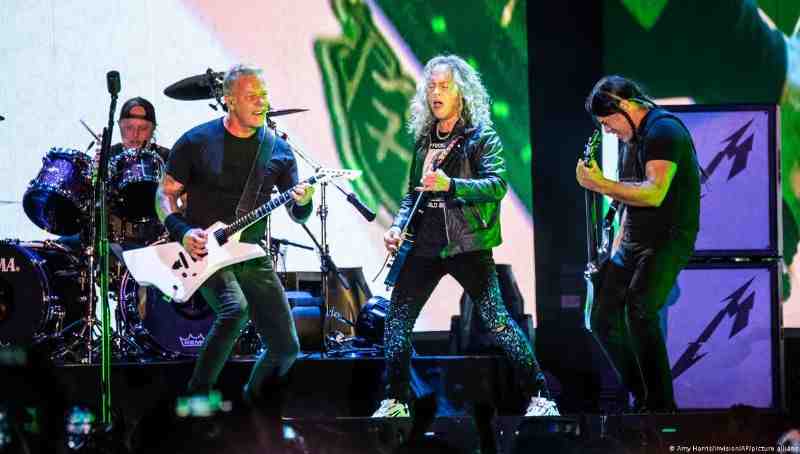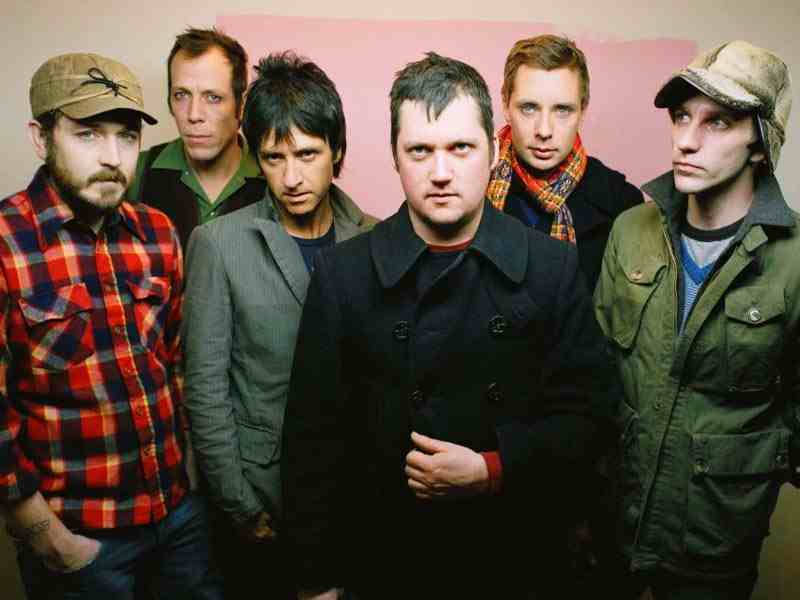The letter M represents an array of iconic bands that have shaped various music genres over decades.
From metal to pop, bands starting with M such as Metallica, Muse, Mötley Crüe, Maroon 5, Mumford & Sons, Matchbox Twenty, Megadeth, Mastodon, Manic Street Preachers, and Modest Mouse have produced memorable songs and albums that resonate with listeners worldwide. Their music has appealed to fans all over the globe and introduced new listeners to various styles.
This article explores the histories, members, highly skilled musicianship, songwriting talents, and most influential works of ten renowned bands that start with the alphabet with M, discussing their impact on the genres they pioneered or reinvented around the world.
We have also covered other bands that start with other Alphabets from A to Z.
[recommended_posts posts=”1720,1724,1731,1735,1763,1766″]
| Band | Year Formed | Members | Notable Albums | Genres | Impact |
|---|---|---|---|---|---|
| Metallica | 1981 | James Hetfield, Lars Ulrich, Kirk Hammett, Robert Trujillo | Ride the Lightning, Master of Puppets, Metallica | Thrash metal, heavy metal | Pioneered thrash metal sound and brought the genre to mainstream popularity |
| Muse | 1994 | Matthew Bellamy, Chris Wolstenholme, Dominic Howard | Origin of Symmetry, Black Holes and Revelations, Simulation Theory | Alternative rock, progressive rock | Blended diverse genres in an innovative way; widely acclaimed for groundbreaking music |
| Mötley Crüe | 1981 | Vince Neil, Nikki Sixx, Tommy Lee, Mick Mars | Shout at the Devil, Girls, Girls, Girls, Theatre of Pain | Heavy metal, glam metal | Epitomized the 1980s Los Angeles glam metal scene; known for its hedonistic image and live shows |
| Maroon 5 | 1994 | Adam Levine, Jesse Carmichael, Mickey Madden, James Valentine | It Won’t Be Soon Before Long, Overexposed, V | Pop rock, R&B, funk, soul | Evolved sound from rock to mainstream pop; global hitmakers known for Adam Levine’s vocals |
| Mumford & Sons | 2007 | Marcus Mumford, Winston Marshall, Ben Lovett, Ted Dwane | Sigh No More, Babel, Delta | Folk, folk rock, indie folk | Revived folk and Americana styles among youth; known for communal live performances |
| Matchbox Twenty | 1995 | Rob Thomas, Kyle Cook, Brian Yale, Paul Doucette | Yourself or Someone Like You, More Than You Think You Are | Rock, pop rock, post-grunge | Blended melody and emotion for rock radio; shaped radio-friendly rock in the late 90s |
| Megadeth | 1983 | Dave Mustaine, David Ellefson, Dirk Verbeuren | Peace Sells…But Who’s Buying?, Rust in Peace, Dystopia | Thrash metal, heavy metal | Pioneered fast, technical thrash style; expanded lyrical and musical complexity in metal |
| Mastodon | 2000 | Brent Hinds, Bill Kelliher, Brann Dailor | Leviathan, Blood Mountain, Crack the Skye | Sludge metal, progressive metal | Masterfully fused genres; raised the bar for progressive metal artistry and musicianship |
| Manic Street Preachers | 1986 | James Dean Bradfield, Sean Moore, Nicky Wire | The Holy Bible, Everything Must Go, Journal For Plague Lovers | Alternative rock, post-punk | Added layers to rock with intellect and aggression; influenced the alt-rock scene |
| Modest Mouse | 1993 | Isaac Brock, Tom Peloso, Brian Mashburn | The Lonesome Crowded West, The Moon & Antarctica | Indie rock, alternative rock, indie folk | Pioneered lo-fi PacNW style; subverted norms to shape eclectic indie rock creativity |
10 Best Bands That Start With M:
Here are the most influential and popular bands that start with the M alphabet:
1. Metallica

What is the history of Metallica?
Formed in 1981 in Los Angeles, Metallica originated from the members of other bands looking to start a heavier, more aggressively played metal band.
Guitarists James Hetfield and Lars Ulrich were joined by Dave Mustaine and Ron McGovney to form the group’s earliest lineup. They began playing clubs and honing their instrumental skills together, striving to outdo other metal bands in terms of sheer aggression, intensity, and musicianship.
Who are the core members of the band?
Now consisting of Hetfield, Ulrich, guitarist Kirk Hammett, and bassist Robert Trujillo, Metallica is renowned for its instrumental prowess and musical intensity. Beyond their instrumentation, the members also contributed to songwriting, providing lyrics that dealt with complex themes.
Hetfield provides harsh yet melodic vocals alongside his rhythm guitar work, while Ulrich’s precise drumming drives their signature sound. Hammett contributes technically skilled lead guitar solos that complement Hetfield’s rhythms.
What are Metallica’s most influential albums and songs?
Known for genre-defining albums Ride the Lightning (1984), Master of Puppets (1986), and the self-titled 1991 record, Metallica established the template for thrash metal with anthems like “Enter Sandman,” “Nothing Else Matters,” “One”, “Master of Puppets”, and “Seek & Destroy.”
Their albums showcase the band’s progressive songwriting abilities within an aggressively played metal framework. The albums sold millions worldwide and influenced countless bands with their combination of sophisticated compositions and intensity.
How has Metallica shaped the heavy metal genre?
Though initially dismissed by some for selling out, Metallica earned mainstream success while maintaining their musical integrity. The band’s early works influenced multiple generations of metal acts with their blend of lightning-fast riffs, anguished lyrics, and dramatic solos.
Beyond musicians, Metallica also impacted the culture at large by popularizing metal on a global scale like no act before or since. Their albums demonstrated that metal could achieve both artistic merit and commercial success.
2. Muse

What is the background of Muse?
Formed in 1994 in Teignmouth, England, Muse is composed of Teignmouth Grammar School friends Matthew Bellamy, Chris Wolstenholme, and Dominic Howard.
Their unique blend of rock, metal, classical, and electronica emerged from the members’ diverse musical influences and inspirations from various genres. They immersed themselves in different styles to create their multifaceted sound.
Who are the key members of the band?
Frontman and pianist Matthew Bellamy possesses a powerful, operatic voice and is renowned as one of rock’s most talented guitarists. Bassist Wolstenholme and drummer Howard form an intricate and frenetic rhythm section.
All three members share songwriting credits, with Bellamy contributing the bulk of the lyrics in addition to instrumental parts.
What are Muse’s most popular and critically acclaimed works?
Showcasing Bellamy’s multi-instrumental skills, albums like Origin of Symmetry (2001) and Black Holes and Revelations (2006) earned Muse mainstream success. Singles “Uprising,” “Madness,” and “Starlight” highlight their anthemic sound and talents for crafting modern rock hits.
Drones (2015) and Simulation Theory (2018) further explored sci-fi themes through layered compositions and arrangements featuring complex time signature changes.
How has Muse blended various genres in their music?
By incorporating elements of classical piano and electronica, Muse crosses genres within hard-hitting rock songs. Their technical proficiency and melodic sensibilities bring a cinematic quality, all enhanced by Bellamy’s soaring voice and emotional delivery.
Muse continues to push stylistic boundaries with each new release, gaining acclaim for pioneering their genre-bending fusion of sounds that inspires other bands.
3. Mötley Crüe

What is the origin of Mötley Crüe?
Formed in 1981 in Los Angeles, Mötley Crüe emerged amidst the rising ’80s LA hair metal scene. Vocalist Vince Neil, bassist Nikki Sixx, drummer Tommy Lee, and guitarist Mick Mars came together sharing a love of rock and roll as well as a ragged musical style befitting their notorious bad boy image. They built their reputation through relentless touring and performances.
Who were the members of the band?
Neil provided the charismatic frontman persona, while Sixx, Lee, and Mars crafted hard-riffing anthems punctuated by dynamic drumming. Though their personal lives became as infamous as their music, these founders solidified Mötley Crüe’s rowdy rock reputation worldwide. Their on-stage antics and excessive lifestyles fueled legend and tabloid stories.
What are Mötley Crüe’s most iconic albums and songs?
Theatrically-titled records like Shout at the Devil (1983) and Girls, Girls, Girls (1987) contained combustible singles like “Live Wire,” “Dr. Feelgood,” and “Girls, Girls, Girls” that defined the decadent hair metal era. Theatre of Pain (1985) showed further musical growth and cemented their status as leaders of the glam metal scene through catchy songs.
How did Mötley Crüe contribute to the glam metal scene?
More so than their peers, Mötley Crüe came to represent hair metal through wildly extravagant live performances featuring pyrotechnics and larger-than-life personas.
While their music was not the most sophisticated, Mötley Crüe remained the archetypal bad boys of glam whose hedonistic image came to epitomize the genre itself for audiences internationally. Their shows set the standard for visual excess in metal spectacles.
4. Maroon 5

What is the history of Maroon 5?
Originally formed as Kara’s Flowers in 1994 by high school friends Adam Levine, Jesse Carmichael, Mickey Madden, and Ryan Dusick, the band later changed its name to Maroon 5 to pursue a more mature sound.
They found mainstream success after several years of hustling and finally crafting a neo-soul sound layered with instantly appealing pop-friendly songwriting and hooks.
Who are the core members of the band?
Frontman and voice Adam Levine is the face of Maroon 5, with his soulful pipes carrying anthemic pop songs to global audiences. Pianist Jesse Carmichael, bassist Mickey Madden, drummer Matt Flynn, keyboardist PJ Morton, and guitarist James Valentine complete their current lineup with versatile playing across genres.
What are Maroon 5’s most successful songs and albums?
Hits like “This Love,” “She Will Be Loved,” and “Moves Like Jagger” made their multi-platinum album It Won’t Be Soon Before Long (2007) an inescapable mainstream triumph. More recent songs like “Girls Like You” and “Memories” blended styles and topped the charts internationally.
How has Maroon 5’s sound evolved from rock to pop?
Once a conventional rock band, they found new audiences by blending influences like funk, R&B, and electronic dance sounds into a slick, radio-ready pop package layered with hooks.
Adam Levine became a household name as the band’s crossover appeal expanded globally by crafting songs that were easy for all to enjoy but still showed musicianship.
5. Mumford & Sons

What is the story behind Mumford & Sons?
Originating from London in 2007, Marcus Mumford, Ben Lovett, Winston Marshall, and Ted Dwane combined acoustic grassroots folk with a dynamic rock vigor. Their signature four-part harmonies and rhythmic folk-rock sound emerged from playing many underground London pub gigs in their early days. They soon developed a loyal following through their lively live shows.
Who are the key members of the band?
Vocalist and guitarist Marcus Mumford leads with a soulful voice, while Winston Marshall plays energetic banjo, and guitar and provides high tenor vocals. Bassist and keyboardist Ben Lovett, and drummer Ted Dwane round out the tight folk-rock quartet. They worked diligently to hone their instrumental and vocal blending.
What are Mumford & Sons’ most acclaimed works?
Breakthrough album ‘Sigh No More’ (2009) and follow-up ‘Babel’ (2012) earned critical praise for essential folk-rock cuts like “The Cave,” “Little Lion Man,” and “I Will Wait” that resonated globally. ‘Wilder Mind’ (2015) showed expanded arrangements and songwriting. ‘Delta’ (2018) continued their blend of roots and indie styles to wider recognition.
How did Mumford & Sons influence the folk-rock revival?
By bringing youthful energy and passion to traditional folk, their music inspired a new generation to appreciate the genre in a new light. Mumford & Sons soaring harmonies and communal live shows made them flag-bearers for orchestral folk-rock’s mainstream resurgence in the 2010s. Their dedication revitalized interest in live, sincere music.
6. Matchbox Twenty

What is the background of Matchbox Twenty?
Formed in Orlando, Florida in 1995, Matchbox Twenty was fronted by singer-songwriter Rob Thomas with guitarist Kyle Cook, bassist Brian Yale, and drummer Paul Doucette. Their modern rock sound gained great popularity in the post-grunge era through airplay on rock radio stations.
Who were the members of the band?
With Thomas leading as composer and crooner, Cook (also the group’s main songwriter), Yale, and Doucette formed the core original lineup. Matchbox Twenty presented radio-ready yet soulful rock anchored by melodic guitar riffs and infectious vocal hooks that brought fans nationwide to their shows.
What are Matchbox Twenty’s most popular albums and songs?
Their diamond-certified debut Yourself or Someone Like You (1996) contained smash hits like “Long Day” and “Push,” while More Than You Think You Are (2002) included the enduring hit “If You’re Gone.” Standouts like “Bent,” “Unwell,” and “3 A.M.” exemplified their relatable nature and songwriting gifts.
How did Matchbox Twenty contribute to the post-grunge era?
While grunge dominated rock, Matchbox Twenty filled the void by blending emotive songwriting strengths and polished musicianship for rock radio.
With infectious lyrics and melodies, Matchbox Twenty introduced many to introspective rock music and influenced subsequent rock bands to pursue a radio-friendly sound while showing off instrumental talents.
7. Megadeth

What is the origin of Megadeth?
After leaving Metallica, guitarist Dave Mustaine formed Megadeth in Los Angeles in 1983. The band’s name was a play on the term “megadeath,” representing his intent to create a much heavier, more complex style of metal than mainstream acts through ambitious compositions.
Who are the core members of the band?
Mustaine defined the band’s visceral style by bringing his blazing lead guitar skills and harsh vocals. Fellow original members David Ellefson and Nick Menza rounded out an ever-evolving lineup under Mustaine’s strict leadership over the decades. He steered their dynamic sound through lineup changes.
What are Megadeth’s most significant works?
Groundbreaking albums Killing Is My Business… (1985) and Peace Sells…But Who’s Buying? (1986) helped establish aggressive thrash metal. Rust in Peace (1990) displayed technical mastery. Endgame (2009) and Dystopia (2016) kept their signature sound modern through advanced arrangements.
How has Megadeth influenced the thrash metal genre?
Megadeth brought thought-provoking lyrical perspectives and groundbreaking musicianship that expanded boundaries of speed and intensity.
Mustaine’s precision riffing wrote the blueprint for contemporary metal shredder subgenres to follow. Megadeth remains revered among the metal elite for consistently innovating within their politically-minded music.
8. Mastodon

What is the history of Mastodon?
Hailing from Atlanta, Mastodon emerged in 2000 combining progressive metal complexity, sludge heaviness, and melodic accessibility through multi-faceted compositions. Guitarists Brent Hinds and Bill Kelliher, bassist Troy Sanders, and drummer Brann Dailor crafted a signature sound by experimenting with different elements.
Who are the key members of the band?
All four Mastodon members share varied vocal styles amidst their intricate instrumental interplay. Sanders and Dailor provide clearer singing contrasted by Hinds’ gritty roars. Kelliher’s dexterous riffing is punctuated by Dailor’s polyrhythmic percussion. They honed intense live performances.
What are Mastodon’s most acclaimed albums and songs?
Remission (2002) revealed their artistic ambition. Leviathan (2004) and Blood Mountain (2006) reflected technical growth. The Hunter (2011) showed melodic mastery. Once More ‘Round the Sun (2014) maintained consistency of style. Cuts like “Blood and Thunder” endure as pioneering anthems.
How has Mastodon blended various metal subgenres?
By skillfully incorporating sludge, progressive, and melodic death influences, Mastodon created their multifaceted sound distinguished by dynamic changes, complex rhythms, and discordant guitar harmonies within catchy songs. Remaining adventurous, they set the bar for contemporary progressive metal through artistry.
9. Manic Street Preachers

What is the background of Manic Street Preachers?
Formed in 1986 in Blackwood, Wales, Manic Street Preachers fused American indie styles with British rock by adding layers of melody and aggression. Vocalist-guitarists James Dean Bradfield and Sean Moore, with bassist Nicky Wire, emerged during the growth of British alternative rock using various instruments.
Who are the core members of the band?
Bradfield and Moore comprised the band’s rhythmic backbone. As their main provocative lyricist, Wire represented their intellectual spirit through thought-provoking words. Drummer Sean Moore provided the steady drive enabling their blends of melody, politics, and intensity in live performances.
What are Manic Street Preachers’ most significant works?
The Holy Bible (1994) showed post-punk ambition. Everything Must Go (1996) made them internationally renowned for anthems like “A Design for Life.” Journal for Plague Lovers (2009) maintained their creative edge in later years through complex arrangements.
How has Manic Street Preachers contributed to the alternative rock scene?
By pushing beyond conventions to craft artfully powerful narratives and melodies, Manic Street Preachers made rock more thoughtful without sacrificing energy. The band’s intellectualism and refusal to follow trends inspired generations of alternative bands to challenge genre standards in artistic ways.
10. Modest Mouse

What is the origin of Modest Mouse?
Formed in 1993 in Issaquah, Washington, Modest Mouse emerged from the Pacific Northwest’s underground scene. Singer/guitarist Isaac Brock crafted obliquely poetic lyrics and unorthodox structures blending indie, punk, and folk through non-traditional songs.
Who are the members of the band?
Alongside Brock throughout frequent lineup shifts, bassist Jeremiah Green and drummer Tom Peloso solidified their avant-garde aesthetic with exploratory sound. Guitarists Johnny Marr and Jim Fairchild currently join Brock in Modest Mouse’s continually evolving lineup.
What are Modest Mouse’s most popular albums and songs?
The Lonesome Crowded West (1997) garnered cult popularity for songs like “Trailer Trash.” The Moon & Antarctica (2000) brought mainstream attention to “Float On” and “Dashboard” through catchy melodies. Strangers to Ourselves (2015) kept their indie stamp by refining pop sensibilities.
How has Modest Mouse influenced the indie rock genre?
By pushing boundaries, Modest Mouse subverted conventions to craft quirkily poetic narratives and melodies. Their DIY spirit helped define the Pacific Northwest indie scene emphasizing lyrical wit and experimentation. Modest Mouse broke barriers for Heartland indie rock around the world.
Bands that start from M: Final Words
From ‘Metallica’ and ‘Megadeth’ establishing metal generations ago, to ‘Maroon 5’ and ‘Matchbox Twenty’ crafting radio rock hits, ‘Mötley Crüe’ igniting the glam scene, and ‘Modest Mouse’ capturing indie sensibilities creatively, each highlighted group brought seminal works that continue resonating with new generations of listeners.
These genre-defining bands exemplify the lasting creativity found within one letter, and their timeless music will remain a treasured component of global culture for many years to come.















